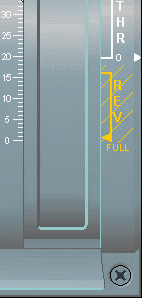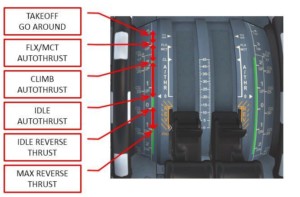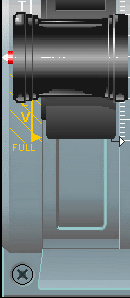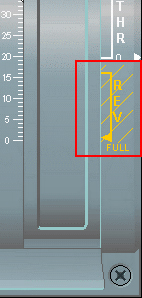



Two thrust levers control engine thrust, or set the authority of the auto thrust system. The levers can only be moved manually; they do not move automatically.
When the thrust levers are moved, they transmit signals to the FADEC, which computes the thrust rating limit and EPR. If a thrust lever is set in a detent, the FADEC selects the rating limit corresponding to that detent. If the thrust lever is set between two detents, the FADEC selects the rating limit corresponding to the higher detent. This limit is displayed on the upper ECAM.
There are five positions defined by stops or detents:
- Takeoff / Go-Around (TO/GA)
- Flex/Max Continuous Thrust (FLX/MCT)
- Climb (CL)
- Forward Idle
- Max Reverse
he auto thrust is disconnected by:
Auto thrust Disconnect Buttons
- Pushing either disconnect button on the thrust levers
- Positioning both thrust levers to the idle stop. Pushing the A/THR button when the auto thrust system is engaged
- Losing of arming signals
- Setting both thrust levers above CL or one thrust lever above MCT with both the flight directors and autopilots off when the radio altitude is below 100 feet
- Max Reverse
| CAUTIONIf an auto thrust disconnect button is pushed and held for more than 15 seconds, the auto thrust system is disconnected for the remainder of the flight. All auto thrust functions, including alpha floor, are lost. The auto thrust system can be regained only during the next FMGC power-up. |
Reverse Thrust Detent
Select reverse thrust by clearing the stop at the forward idle position. The stop is reset when the thrust lever is selected back to forward thrust. When the idle stop is cleared by pulling the reverse levers up, reverse idle is monitored and controlled by the FADEC.
Each engine is equipped with a hydraulically operated fan air reverser. The thrust reversers can only be operated on the ground with a signal from the main landing gear control interface unit (LGCIU). Hydraulic pressure for the operation of the thrust reversers is provided by the associated hydraulic system.
Actuation of the reverse levers causes aft movement of the reverser sleeve, exposing fixed cascade vanes, and closes fan blocker doors to redirect the flow of fan air forward through the vanes to produce reverse thrust.

